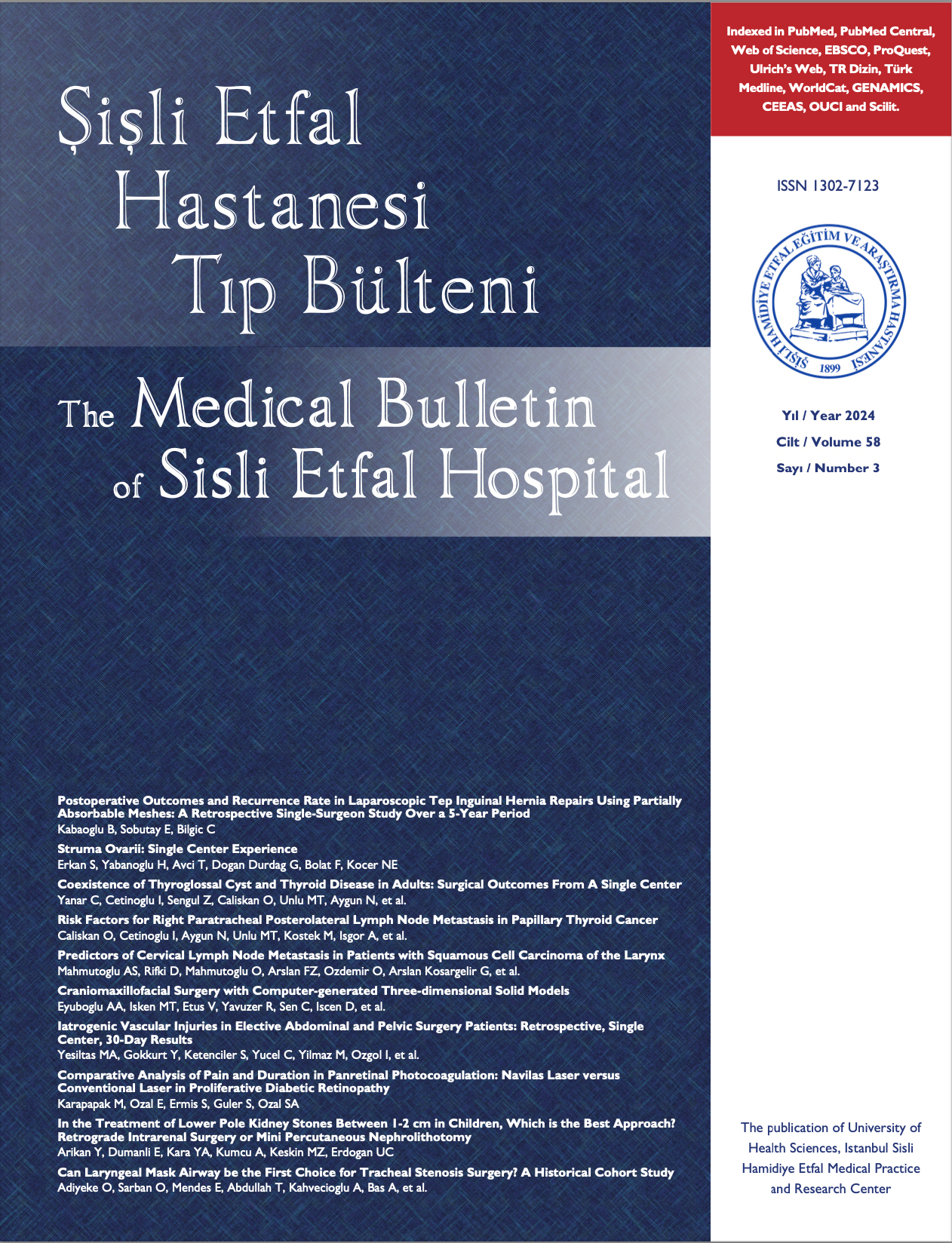
Retrospective Evaluation of Patients Admitted to the Pediatric Neurology Outpatient Clinic with Headache: Experience of a Tertiary Hospital
İlhan Abidin1, Cuneyt Ugur2, Mirac Yildirim31Department of Pediatric Gastroenterology, Selcuk University Faculty of Medicine, Konya, Türkiye2Department of Pediatrics, University of Health Sciences Türkiye, Konya City Health Application and Research Center, Konya, Türkiye
3Department of Pediatric Neurology, Ankara University Faculty of Medicine, Ankara, Türkiye
Objectives: It was aimed to determine the etiological and clinical features of pediatric patients with headache complaints. Methods: The files of patients who were admitted to the pediatric neurology outpatient clinic with headache were reviewed retrospectively. Patients' age, gender, features of headache, symptoms accompanying headache, available blood tests, brain magnetic resonance (MR) and electroencephalography (EEG) results were recorded.
Results: Of the total 470 patients, aged between 3 and 17 years, 291 (61.9%) were female and 179 (39.1%) were male. The mean age of the patients was 12.38±3.45 years. According to age groups, there were 16 (3.4%) patients under the age of 5, 159 (33.8%) between the ages of 6-11, and 295 (62.8%) patients aged 12-17 years. While 289 (61.5%) patients were diagnosed with primary headache, 122 (26.0%) patients were diagnosed with secondary headache, and headaches of 59 (12.5%) patients could not be classified. The most common primary headaches were tension-type headache (TTN) (n=177, 37.7%) and migraine (n=111, 23.6%). The 86 (70.5%) of the patients with secondary headache were diagnosed with sinusitis. Abnormal neurological examination finding was determined in 8 (1.7%) patients. Brain MR was performed in 439 (93.4%) of all patients and abnormal brain MR findings were detected in 52 (11.8%) patients. EEG was performed in 205 (43.6%) of all patients and abnormal EEG findings were detected in 24 (11.7%) patients.
Conclusion: According to age groups, headache was most common in the 12-17 age group. The most common causes of headache were TTN and migraine, respectively. The most common secondary headache cause was sinusitis. We think that physical and neurological examination still maintains its priority in determining the causes of headache.
Çocuk Nörolojisi Polikliniğine Baş Ağrısı ile Başvuran Hastaların Retrospektif Olarak Değerlendirilmesi: Üçüncü Basamak Hastane Deneyim
İlhan Abidin1, Cuneyt Ugur2, Mirac Yildirim31Selçuk Üniversitesi Tıp Fakültesi, Pediatrik Gastroenteroloji Anabilim Dalı, Konya2Türkiye Sağlık Bilimleri Üniversitesi, Konya İl Sağlık Uygulama ve Araştırma Merkezi, Çocuk Sağlığı ve Hastalıkları Kliniği, Konya
3Ankara Üniversitesi Tıp Fakültesi, Pediatrik Nöroloji Anabilim Dalı, Ankara
Amaç: Baş ağrısı yakınması olan çocuk hastaların etyolojik ve klinik özelliklerini belirlemek amaçlandı.
Yöntem: Çocuk nöroloji polikliniğine baş ağrısı şikayeti ile başvuran hastaların dosyaları retrospektif olarak incelendi. Hastaların yaşı, cinsiyeti, baş ağrısının özellikleri, baş ağrısına eşlik eden semptomlar, mevcut kan tetkikleri, beyin manyetik rezonans (MR) ve elektroensefalografi (EEG) sonuçları kaydedildi.
Bulgular: Yaşları 3-17 yıl arasında değişen toplam 470 hastanın 291'i (%61,9) kadın, 179'u (%39,1) erkekti. Hastaların yaş ortalaması 12,38 ± 3,45 yıl idi. Yaş gruplarına göre 5 yaş altı 16 (%3,4), 6-11 yaş arası 159 (%33,8), 12-17 yaş arası 295 (%62,8) hasta vardı. 289 (%61,5) hastaya primer baş ağrısı tanısı konulurken, 122 (%26,0) hastaya sekonder baş ağrısı tanısı kondu ve 59 (%12,5) hastanın baş ağrısı sınıflandırılamadı. En sık görülen primer baş ağrıları gerilim tipi baş ağrısı (GTB) (n: 177, %37,7) ve migren (n: 111, %23,6) idi. Sekonder baş ağrısı olan hastaların 86'sına (%70,5) sinüzit tanısı kondu. Sekiz (%1,7) hastada anormal nörolojik muayene bulgusu saptandı. Tüm hastaların 439'una (%93,4) beyin MR çekildi ve 52 (%11,8) hastada anormal beyin MR bulgusu saptandı. Tüm hastaların 205'ine (%43,6) EEG çekildi ve 24 (%11,7) hastada anormal EEG bulgusu saptandı.
Sonuç: Yaş gruplarına göre, baş ağrısı en sık 12-17 yaş grubunda görüldü. Baş ağrısının en yaygın nedenleri sırasıyla GTB ve migrendi. En yaygın ikincil baş ağrısı nedeni sinüzitti. Baş ağrısı nedenlerinin belirlenmesinde fizik ve nörolojik muayenenin hala önceliğini koruduğunu düşünüyoruz. (SETB-2023-08-132)
Manuscript Language: English



















